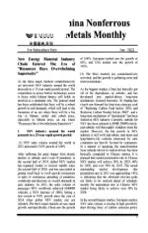MLR will Continue to Control the Total Exploitation Quantity of Advantageous Mineral Resources Including Rare Earth
2011-08-15
According to Wang Min, Vice Minister of Land and Resources and chief of China Geological Survey, for some time to come the MLR will continue to implement the policy of controlling the total exploitation quantity of advantageous mineral resources, exercising classified macro-control and strict control over high-pollution minerals, and promote regional cooperation in the regulation of the development of local advantageous mineral resources like phosphate.
That means China continues to control the total exploitation quantity of advantageous mineral resources such as tungsten, antimony and rare earth.
According to data from the MLR, in 2011 China curtailed its total output of rare earth oxides (REO) to 93,800 tons, 460 tons more than last year’s figure. This includes 80,400 tons of light rare earth, and 13,400 tons of middle and heavy rare earth. Rare earth is one of the five protected minerals in China. Since 2007, the MLR has issued total control targets on exploitation quantity to rare earth enterprises across the nation for five consecutive years.
According to Wang, since 2005, 6,574 mines have been consolidated, involving important mineral resources like iron, copper and aluminum. The total number of mines in China fell from 127,000 in 2005 to 113,000 in 2010,down by 11.2%. In 2010, solid mines’ output totaled 9 billion tons in the country, up by 3.8 billion tons from 2005.
The MLR will explore new approaches to consolidate owners of exploration right, press ahead with the integrated development of rare earth and other mineral resources, conduct routine management of integrated development,merger and reorganization of mining enterprises, and eliminate outdated production capacity in key fields, according to Wang.
Meanwhile, the MLR will work with the Legislative Affairs Office of the State Council and other agencies to clear up local policy of mineral resource management, and step up centralized management. It will also standardize classified assignment of mining right, tighten entry and exit management, and curb hyping of mining
杂志排行
China Nonferrous Metals Monthly的其它文章
- Rising Status of Private-owned Enterprises in the Nonferrous Industry
- Variable Frequency Air Conditioner is Expected to Become Mainstream Product in Rural Market
- A Large Copper Lead-Zinc Deposit Found in Qaidam
- Jieshou to Build A Megaton Secondary Metals Market
- Galuminum Project to Yield 800,000 Tons of Alumina Annually in Phase I
- Study of Copper Substitute in High Copper Price Market Environment
